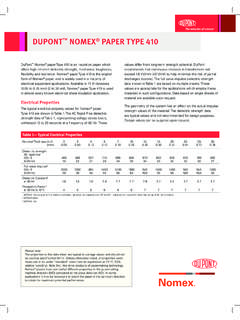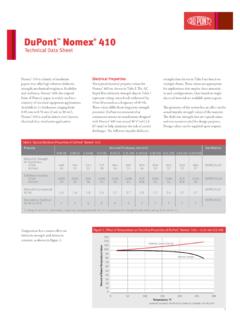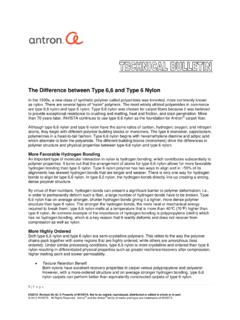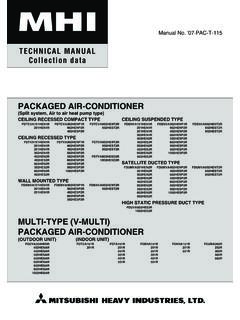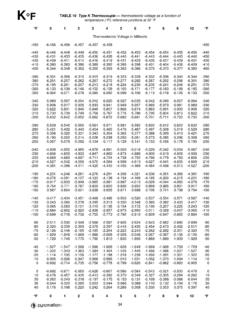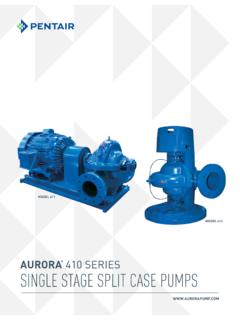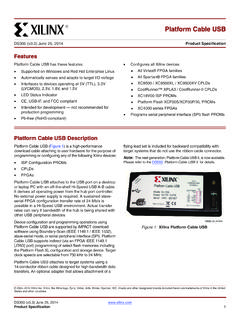Transcription of Types 410, 420, 425 Mod, and 440A - stal.com.cn
1 Types 410, 420, 425 mod , and 440a . GENERAL PROPERTIES chromium carbide particles, and the greater the strength and hardness for heat treatable straight- Types 410, 420, 425 Modified, and chromium stainless steels. 440A (see composition on Page 2) are hardenable, straight-chromium stainless steels which combine superior wear resistance of high carbon alloys with the When blanking cutlery parts from annealed raw excellent corrosion resistance of chromium stainless material stock, Types 410, 420, and their higher steels. Oil quenching these alloys from temperatures carbon versions ( Types 410HC and 420HC) will between 1800 F to 1950 F (982-1066 C) produces usually exhibit hardness, yield strength, and tensile the highest strength and/or wear resistance as well as strength that are low enough for fine blanking pur- corrosion resistance.
2 A range of as-quenched poses. However, Type 440A is not readily amenable to hardnesses is achieved in these alloys by varying the fine blanking due to its higher strength and hardness carbon level from .15% maximum in Type 410 to .60- in the annealed condition; and therefore, could require .75% in Type 440A. more powerful presses to blank parts. In addition, the presence of large primary carbides in Type 440A. would tend to reduce die life. These alloys are used where strength, hardness, and/. or wear resistance must be combined with corrosion resistance. When buffing blanked parts, the higher hardness of Type 440A in the heat treated condition (hardened). would mean less residual buffing lines on the surfaces APPLICATIONS of parts but the large primary carbides could be dislodged during buffing which would produce A major use for these grades of heat treatable stain- scratches called comet-tails.
3 Stainless steels lower in less steels is in cutlery. Depending on the customer's carbon content are essentially free of "comet-tails". end-use requirements, cutlery alloys are usually selected with respect to heat treating response, mechanical properties and fabricating characteristics. Other applications for these grades include dental and surgical instruments, nozzles, valve parts, hardened steel balls and seats for oil well pumps, separating When sufficient amounts of carbon are added to screens and strainers, springs, shears, and wear straight- chromium stainless steels, the alloy then has surfaces. the capability to transform its microstructure through proper heat treatment (hardening) into one that will possess optimum strength, hardness, edge retention, PRODUCT FORM.
4 And wear resistance. The presence of sufficient chromium will impart the necessary corrosion resis- These alloys are available as plate, sheet, strip and tance and form chromium carbide particles that flat bars. enhance the wear resistance of the given alloy. The higher the carbon content, the greater the amount of CHEMICAL COMPOSITION. Stainless Element in Weight Percent Steels Carbon Manganese Silicon Chromium Molybdenum Nickel Sulfur Phosphorus Type 410* max max max -- max max max Type 420** max max --- max max max Type 425 mod max max max max max Type 440A max max max max max max *A higher carbon version of Type 410 is also available called Type 410HC (nominal C). **A higher carbon version of Type 420 is also available called Type 420HC (nominal C).
5 MECHANICAL PROPERTIES. Typical compositions, annealed mechanical properties and hardening response for the various Allegheny Ludlum martensitic stainless steels are presented below. Typical Composition Typical Annealed (Weight Percent) Properties Hardening Offset Tensile Elongation, Response Stainless C Cr Mo HRB Yield Strength Strength Percent in HRC. Steels Ksi (MPa) Ksi (MPa) 2" (51 mm). Type 440A -- 95 62 (427) 104 (717) 20 57-60. Type 425 mod 93 55 (379) 94 (648) 24 57-60. 89* 45 (310) 86* (593) 25*. Type 420HC** -- 88 45 (310) 87 (600) 28 56-59. Type 420 -- 87 45 (310) 85 (586) 29 53-57. Type 410HC** -- 83 43 (310) 78 (538) 30 45-52. Type 410 -- 82 42 (290) 74 (510) 34 38-45. * Fine blanking quality **HC means higher carbon version of standard grade 2.
6 Data shown below give typical mechanical properties Modulus of Elasticity of martensitic stainless steels obtained with various 29 x 106 psi (200 GPa). drawing temperatures after austenitizing at 1800- 1950 F (982-1066 C) followed by an oil quench and a two hour temper. Heat-to-heat variations can be anticipated. Typical Mechanical Properties of Heat Treated Martensitic Stainless Steels T410 ( %C) T420 ( %C) T425 Mod ( %C) T440A ( %C). Hardened 1800 F (982 C) Hardened 1900 F (1038 C) Hardened 1900 F (1038 C) Hardened 1900 F (1038 C). Heat Treatment Rockwell UTS, UTS, UTS, UTS, YS, Rockwell YS, Rockwell YS, Rockwell YS, Ksi Ksi Ksi Ksi Hardness Ksi Hardness Ksi Hardness Ksi Hardness Ksi (MPa) (MPa) (MPa) (MPa). (MPa) (MPa) (MPa) (MPa). Annealed* 81 HRB 85 HRB 90 HRB 94 HRB (313) (554) (355) (592) (396) (595) (354) (747).
7 Hardened+. Tempered 43 HRC 48 HRC 53 HRC 54 HRC 400 F (1076) (1399) (1311) (1759) (1385) (1868) (1579) (2022). (204 C). Hardened+. Tempered 40 HRC 44 HRC 50 HRC 50 HRC 550 F (1022) (1289) (1213) (1583) (1360) (1729) (1518) (1879). (288 C). Hardened+. Tempered 40 HRC 45 HRC 53 HRC 53 HRC 600 F (1026) (1283) (1234) (1606) (1351) (1690) (1531) (1883). (316 C). Hardened+. Tempered 41 HRC 46 HRC 53 HRC 53 HRC 800 F (916) (1300) (1280) (1627) (1452) (1759) (1610) (1881). (427 C). Hardened+. Tempered 41 HRC 46 HRC 52 HRC 52 HRC 900 F (845) (1298) (1236) (1606) (1368) (1619) (1466) (1858). (482 C). Hardened+. Tempered 35 HRC 36 HRC 43 HRC 41 HRC 1000 F (882) (1063) (951) (1093) (1218) (1434) (1013) (1224). (538 C). Hardened+. Tempered 98 HRB 23 HRC 29 HRC 31 HRC 1200 F (589) (767) (652) (838) (743) (936) (727) (933).
8 (649 C). *See Heat Treatment section for annealing information 3. For maximum hardness and strength, a hardening heat treatment is necessary. The stainless steel alloys shown in the table on Page 3 were heated as sheet samples for 60 minutes per inch of thickness at 1800 F (982 C) for Type 410 and at 1900 F (1038 C). for Types 420, 425 Modified, and 440a , and then air cooled to room temperature. The as-quenched structure of fresh martensite must be tempered to restore some ductility. The samples depicted in the table were tempered at temperatures from 400 F. (204 C) to 1200 F (649 C) for two hours; note that their hardnesses and strengths changed very little with increases in tempering temperature up to 900 F. (482 C). PHYSICAL PROPERTIES.
9 The values reported below are typical for the alloys in the annealed condition. Type Type Type Type Property 410 420 425 mod 440A. Specific Gravity Density Lbs / in3. Specific Heat Btu/lb. F .11 .11 .11 .11. Thermal Conductivity at 212 F (100 C) Btu/(hr ft F) W/m K. Electrical Resistivity Microhm-cm 68 F (20 C) 56 56 61 62. Coefficient of Thermal Expansion 68 - 392 F, in/in F x 10-6 x 10-6 x 10-6 x 10-6. 20-200 C, cm/cm/ C x 10-6 x 10-6 x 10-6 x 10-6. 68-1112 F, in/in/ F x 10-6 x 10-6 x 10-6 x 10-6. 20-600 C, cm/cm/ C x 10-6 x 10-6 x 10-6 x 10-6. Melting Range 2700-2790 F 2650-2750 F 2600-2750 F 2550-2750 F. 1482-1532 C 1454-1510 C 1427-1510 C 1399-1510 C. 4. CORROSION RESISTANCE Their exposure to chlorides in everyday type activities ( , food preparation, sport ) is generally Types 410, 420, 425 mod , and 440a exhibit good satisfactory when proper cleaning is performed after corrosion resistance to atmospheric corrosion, potable exposure to use.
10 See additional comments on water, and to mildly corrosive chemical enviroments corrosion properties under the section Surface because of their ability to form a tightly adherent oxide Preparation . film which protects their surfaces from further attack. General Corrosion Behavior Compared With Other Nonaustenitic Stainless Steels*. Corrosion Rate in Mils per Year and Millimeters per Year (mm/a). 5% Test Solution at 120 F (49 C) Type Type Type Type Type Type 409 410 420 425 mod 440A 430. Acetic Acid ( ) ( ) ( ) ( ) ( ) ( ). Phosphoric ( Acid ( ) ( ) ( ) ( ) ( ) ( ). *Hardened martensitic grades were tested after tempering at 400 F (204 C). As shown in the above table, these alloys have good corrosion resistance to low concentrations of mild organic and mineral acids.)

